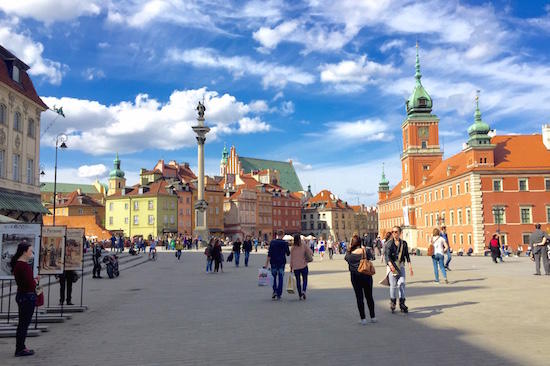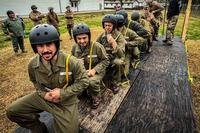
Warsaw, Poland's Old Town
May 8th marks the 70th anniversary of World War II's VE Day. Most Americans consider Victory in Europe as being the logical end result of the June 1944's D-Day Invasion and don't think much about the battles on the Eastern Front. That probably has a lot to do with the Cold War and the forty years we spent thinking about the Soviet Bloc as one solid block.
I got a new perspective when I spent a day touring WWII landmarks in Poland's capital during my visit to Warsaw for the World of Tanks Grand Finals last month. Warsaw endured almost unparalleled devastation during the conflict and dealt with that destruction in a most surprising way.

Warsaw Uprising Memorial
Poland had developed a strong national identity after the Great War and the Poles never really buckled after the Nazi invasion in 1939. In 1944, after it became apparent that Germany was likely to lose the war, the 50,000-strong Army Krajowa (Polish Home Army) decided to drive the Germans from their country and the uprising began on August 1, 1944.
The Soviet generals didn't want to divert resources to aid the Poles, Hitler became enraged and the Germany army set out to obliterate the city. By the beginning of October, most of the city had been leveled and the prized historic district was razed to the ground.

Reconstructed Warsaw
If the Polish people had waited out the war and allowed the Soviet army to liberate Warsaw, there certainly would've been damage but much of its Old World charm would've stayed intact, much like what you'll see if you visit Prague or Budapest.

Warsaw decided to rebuild the destroyed parts of the old city. "Rebuild" meant "recreate" and the old city now is a virtual reproduction of what was there before. From one perspective, it's kind of like Disneyland: a 20th-century facsimile of historic Europe. From another, more interesting point of view, it's a powerful and elegant rebuttal to Nazi destruction. Imagine if the United States had exactly rebuilt the World Trade Center twin towers after 9/11 as a defiant gesture against terrorism. Spend a few hours in rebuilt Warsaw and you get a strong sense of character and national identity in a country that refused to be defined by WWII.

Warsaw's rebuilt Barbican gate, originally constructed in 1540.
Of course, the obvious contrast is France. The French laid down for the Nazi invasion and the Monuments Men helped make sure the Allies didn't blow up too many important buildings when they took it back. After a couple of days in Warsaw thinking about their heroic resistance, it'll be hard to ever enjoy the sights of Paris in quite the same way again.

The Cathedral of St. John church, one of the few rebuilt structures to incorporate more contemporary architecture
Poland is still a country with a heavy burden from the era. It had one of the largest Jewish populations in the world in 1939, approximately 3.3 million people. There are 25,000 Jews living in Poland today.

Poland's martial heritage is on display at the Polish Army Museum, with exhibits that cover more than 1000 years of armor and weapons from the multitude of states that have existed in this part of the world.

The medieval armaments are especially elaborate and impressive. There is a massive amount of armor and an impressive collection of swords. There are a few explanatory signs in English here and there, but the efforts to be Brit and American tourist-friendly are generally pretty inconsistent.

There's also quite a few weapons designed and manufactured by the Polish resistance during WWII.

And some German Engima machines for the espionage aficionados.

The Kubus is a armored vehicle designed and built by the Polish resistance during the Warsaw Uprising in August 1944. It carried 8-12 troops and was armed with two machine guns and a flamethrower.

ZSU-57-2 Self Propelled Anti-Aircraft Cannon (USSR, 1950s)
Poland is now a member of the European Union, so it's easy to come and go if you've got a U.S. passport. They don't use the Euro, preferring to keep the Zloty. It's roughly 4 Zlotys to the U.S. dollar and it's surprising how inexpensive everything is: food, taxis, clothing and admission to movies and museums are all less expensive than other major European cities. There are plenty of Starbucks, McDonalds and KFC restaurants all over the city and a meal at any of them is cheaper than the same meal would be back home. The locals all recommend the burgers and you can get a fully loaded gourmet burger and a pint of local craft beer for less than $10.
If you're deeply interested in the European history of World War II, a trip to Warsaw adds a lot of perspective if you've already seen the bombing sites in London and visited Normandy and Berlin. If you're stationed in Germany, it's easy to get to Warsaw via train and there's a lot of value for your money.




